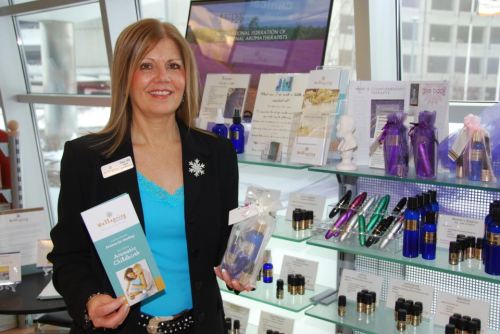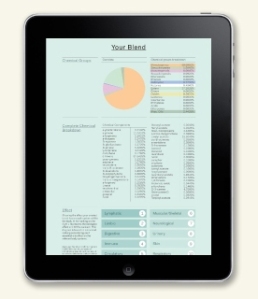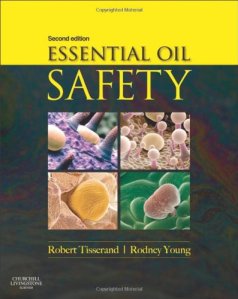 Pam Conrad Discusses Her New Evidence-Based Program
Pam Conrad Discusses Her New Evidence-Based Program
Interview by Leslie Moldenauer CHNC, HHP, Cert. Aroma
Pam Conrad, PGd, BSN, RN, CCAP, earned her Bachelor of Science Nursing degree from Purdue University and has been a registered nurse for over 25 years. Pam completed R J Buckle and Associates 18-month Clinical Aromatherapy course for healthcare professionals in 2000. Pam’s focus in Aromatherapy has always been integrative; combining time-honored nursing and clinical Aromatherapy.
Upon completion of Dr. Buckle’s course, her family moved to England for two years where she studied advanced Aromatherapy with nurses and midwives, and completed a Post Graduate Diploma in Complementary Studies at the University of Westminster Graduate School of Integrated Health, in London. This is where Pam met Denise Tiran and Ethel Burns–two of her mentors–who both specialize in Aromatherapy and pregnancy/childbirth and postpartum. Pam became Ms. Tiran’s first international intern and was able to learn first-hand how to integrate complementary Aromatherapy alongside her traditional practice.
In 2008, Pam taught a group of 12 obstetrics (OB) nurses evidence-based clinical Aromatherapy and developed the first hospital OB Aromatherapy program in the United States (Burns et al., 2000 and 2007). Since that time, multiple hospitals in Indiana (and now Santiago, Chile) have completed this course and developed clinical programs.
Pam currently has the only evidenced-based women’s health/ maternity/clinical Aromatherapy course in the United States that is approved by the American Holistic Nurses Association (AHNA).
LM: Pam, let’s talk a bit more about your evidence-based program being taught here in America. This is a substantial advancement for the industry. What makes your course unique? What is your course offering to potential students?
PC: Historically, the class has been nurses and nurse midwives. The program has recently extended to teach certified doulas as well as certified Aromatherapists. The International Journal of Professional Holistic Aromatherapy will be hosting the first class that includes certified Aromatherapists in February 2017.
The course is focused on labor, childbirth and postpartum. As new clinical evidence emerges, the course content is revised with Aromatherapy interventions for the nine months of pregnancy.
The program takes a clinical approach, which stands out from what is currently being taught in the United States. There are many factors that come into play when making a clinical decision with a patient, not just looking at the chemistry of a particular essential oil. We teach everyone how to analyze the person standing in front of them, looking at their medical history, medications, and to discern how they have responded to different therapies over the course of their lives. Some people react paradoxically to a therapy or an essential oil, this is taken into consideration as well. The clinical judgment and knowledge along with the property of the oils backed by evidence-based research is the basis of how the students are taught.
Another aspect that is covered in great detail is knowing how to decide which women are good candidates for Aromatherapy and which ones are not. We look at possible issues surrounding the neonate, so we teach what should be done for the mom with the baby as well as separate of the baby, in other words without baby present in the room.
In taking this well-rounded and evidence-based clinical approach, I believe that the program is incredibly unique, and very important to the community at large.
LM: Pregnancy and childbirth has until very recently carried with it a stigma, viewing it as a medical condition, rather than a natural and beautiful part of life. Can you talk briefly about how Aromatherapy is being used to facilitate the birthing process?
PC: Pregnancy, labor and childbirth are a beautiful and natural process for the female body. In normal healthy pregnancies, our bodies are well designed to adjust the many functions of our bodies as well as accommodate the growth and development of a fetus. Healthy nutrition, rest, and regular exercise can accomplish this task. At times women do become so uncomfortable with nausea, ingestion, stress, and aches and pains that Aromatherapy is a good choice. Occasional, very dilute and select essential oils used externally; i.e. Lemon (Citrus limon), Lavender (Lavandula angustofolia), and Red Mandarin (Citrus reticulata) have been very effective in our programs.
Unlike what seems like a popular notion, there is no need to help start the labor process. Utilizing Clary sage (Salvia sclerea) for example, is being overused with the idea that a therapist or a nurse can get labor started. This area needs to be understood more fully. If the mother is already in labor, there is no need to increase the contractions. This actually causes what is called hyper-contractions from uterine hyperstimulation (a potential complication of labor induction). This could create a risk for the mother or baby, especially if there are conditions such as cord around the babies neck, placenta previa1 or abrupto.2
The overall goal is to make the mother more comfortable. The more relaxed and comfortable she is, the more likely that natural labor is going to progress, as it should.
LM: Lavender was at one time considered an emmenagogue (uterine stimulant) and was considered contraindicated during pregnancy. In his book, Essential Oil Safety, 2nd Ed., Robert Tisserand dismissed this as a myth as he found no credible research to support that. Recently there has been some debate over this topic. Where do you currently stand on the issue?
PC: There have been some changes recently as far as opinions surrounding Lavender. The experts that I refer to are the clinical experts. When it comes to Aromatherapy, we all find a place to work from that we feel most comfortable, based on our own professional background. Being in the medical field for decades, I focus on the clinical experts and the evidence base, as well as our patient responses. Since beginning our program, we have collected patient data from over 1500 OB hospital interventions.
Historically, the agreement between Ethel Burns and Denise Tiran has been no topical application of Lavender until after the 24th week of pregnancy. The percentage for an acceptable essential oil during pregnancy is 0.5-1%. Once term labor begins this can be increased to 2%. This is a fraction of the dilution that you may have seen recommended often times in the industry.
In a clinical setting, when working with someone who has previous medical conditions or any other red flags; i.e. past miscarriages, in vitro fertilization (IVF), multiples (twins, triplets,etc.) various blood lab abnormalities, high or low blood pressure, and swelling, the decision to be more conservative with Aromatherapy is recommended. For someone with no red flags, a decision may be made to use Lavender at the dilutions mentioned above before the 24-week mark. At that point, the only Lavender that would be used is Lavandula angustifolia, as ketones are a concern with other varieties of Lavender. If the soon-to-be-mother is going through such a high level of stress that it is insurmountable and puts a risk on the pregnancy and she needs help, Lavender (Lavandula angustifolia) may be used.
As long as the mother is not allergic to or dislikes Lavender, it can be used throughout labor and postpartum for anxiety and pain. Red Mandarin is also very helpful for anxiety, indigestion, and nausea and is emotionally uplifting.
As a nurse for many years, the clinical perspective, patient care experience and evidence base all play a part in my practice and courses.
LM: I would like to talk a little bit about your 2012 study conducted with Cindy Adams, “The effects of clinical Aromatherapy for anxiety and depression in the high risk postpartum woman.” Can you tell us a little bit about that clinical study?
The aim of the study was to determine if Aromatherapy is effective at improving anxiety and depression in women at high risk of postpartum depression. It was a study that included 28 women who were all 0-18 months postpartum. The treatment groups were randomized to either inhalation or the Aromatherapy ‘M’ Technique. The treatment consisted of 15 min sessions, twice per week for four consecutive week using a 2% blend of Rose (Rosa damascena) otto and Lavender (Lavandula angustifolia). The non-randomized group avoided all Aromatherapy during this same time period. Allopathic treatment continued for all of the participants.
All subjects completed the Edinburgh Postnatal Depression Scale (EPDS) and
Generalized Anxiety Disorder Scale (GAD-7) at the beginning of the study. The scales were then repeated at the midway point (two weeks), and at the end of all treatments (four weeks).
No significant differences were found between Aromatherapy and control groups at baseline. However, the midpoint and final scores indicated that Aromatherapy had significant improvements greater than the control group on both EPDS and GAD-7 scores. No adverse effects were reported.
The study shows that Aromatherapy is very effective and safe as a complementary therapy in both anxiety and depression with postpartum women.
LM: What do you hope to see for the future of Aromatherapy? What other areas of support for women are you hoping to target in the near future?
Where I see the greatest importance for Aromatherapy during this passage of life is during the post-partum phase and early motherhood. The ability to identify a mom who is at risk for post-partum depression (PPD) is crucial. We can work with them to using Aromatherapy and other complementary therapies to help avoid PPD. We demonstrated the empowering use of the essential oil on mothers and their children in our published pilot study (Conrad and Adams, 2012).
The time during pregnancy and labor is the perfect time to teach a woman how to properly take care of herself during the post-partum period and beyond. When we are able to work as a team, thereby giving us nine months to provide the education to the mom as a complement to their care, greatly increases their quality of life. A mom can then to go to Aromatherapy first, rather than medical treatments, after birth. The postpartum period involves the mother navigating through a myriad of changes, both emotionally and physically. Aromatic complementary therapies can be a perfect stand alone support during the postpartum period for some women. In others, when medication is indicated, it can further support the mother physically and emotionally to improve her quality of life in early motherhood.
The IJPHA is proud to present Pam’s course in Women’s Health for Aromatherapists, nurses, nurse Aromatherapists, midwives, and doulas February 4-5, 2017 in Boulder, Colorado. For information about this program and to register, visit the IJPHA website at http://www.ijpha.com.
[1] Placenta previa is a problem of pregnancy in which the placenta grows in the lowest part of the womb (uterus) and covers all or part of the opening to the cervix.
[2] Placenta abrupto is when the placenta detaches from the wall of the womb (uterus) before delivery.
References
Burns E et al.. (2000). An investigation into the use of Aromatherapy in intrapartum midwifery practice. The Journal of Alternative and Complementary Medicine. 6 (2), p141-147.
Burns E, Zobbi V, Panzeri D, Oskrochi R, Regalia A. (2007). Aromatherapy in childbirth: a pilot randomised controlled trial. BJOG. 114 (7), p838-844.
Conrad P and Adams C. (2012). The effects of clinical Aromatherapy for anxiety and depression in the high risk postpartum woman-A pilot study. Complementary Therapies in Clinical Practice. 18 (3), 164-168.
Leslie Moldenauer has been studying natural living and holistic wellness for over 10 years. She is the owner of Lifeholistically.com, a trusted resource that covers essential oil safety and encompasses all that natural living has to offer. Leslie is passionate about providing education and tools to help others make decisions regarding safety above all things when utilizing aromatherapy in the home. Leslie earned her degree in Complementary and Alternative Medicine (CAM) at the American College of Healthcare Sciences in Portland, Oregon. She is currently earning an advanced diploma in Aromatic Medicine with Mark Webb (Australia), and has trained with Aromatherapy researcher and educator Robert Tisserand.






